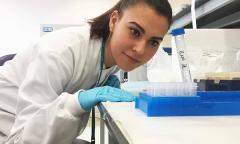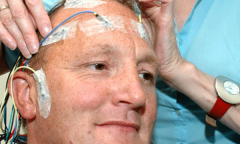Sample type
Serum or plasma
The matrix of choice is serum or plasma, and although they can be used inter-changeably it is preferable to use one or the other. In most clinical settings the measurement of total serum concentrations will suffice and indeed most routine methods for measuring AEDs in sera do not discriminate between the component of drug that is free (unbound) and that that is bound to serum proteins. However, in certain clinical settings when protein binding is altered, patient management would be best guided by monitoring free serum concentrations. Settings in which protein binding impairment occurs include hypoalbuminemia (e.g. during pregnancy, old age, liver disease, renal disease and many other pathological conditions) conditions associated with accumulation of endogenous displacing agents (e.g., uraemia), and administration of drugs which compete for serum protein binding sites. If the free fraction increases, the measurement of the total serum concentration will underestimate the amount of free, pharmacologically active, drug and under these circumstances therapeutic and toxic effects will be observed at total drug concentrations which are lower than usual. Because phenytoin and valproic acid are highly protein bound and consequently susceptible to variable binding, free concentrations are most commonly monitored for these drugs.
Saliva
Saliva is a matrix of increasing utility and is an alternative matrix to serum. For many AEDs salivary concentration reflects the free non-protein bound concentration in blood. This is the ideal concentration measurement as it is the pharmacologically active component that is accessible to the brain where AEDs have their effect. It can be readily undertaken in the home environment with less stress, fear, and discomfort. There is no need for a phlebotomist, nurse or a doctor to bleed the patient.
Overall there is compelling evidence that salivary TDM can be usefully applied so as to optimize the treatment of epilepsy with carbamazepine, clobazam, ethosuximide, gabapentin, lacosamide, lamotrigine, levetiracetam, oxcarbazepine, phenobarbital, phenytoin, primidone, topiramate and zonisamide (Ther Drug Monit 2013;35:4-29). Salivary TDM of valproic acid is probably not helpful whilst for clonazepam, eslicarbazepine acetate, felbamate, perampanel, pregabalin, retigabine, rufinamide, stiripentol, tiagabine and vigabatrin the data are sparse or non-existent.
Saliva testing for all AEDs is included in our ISO15189 accreditation schedule. We are offering saliva collection kits that could be sent out to the patient, and once the patient has returned the kit to us, we will analyse the sample and report the result to you. For more information and details, please contact TDM_Unit@epilepsysociety.org.uk.
Criteria for accepting and rejecting samples
Minimum Data Set for Patient Identification
It is important that certain minimum criteria for sample identification and Request Form details are met.
Sample and request form information must be compatible. The information below indicates the essential data required on samples and request forms and outlines other desirable information, which ideally should also be included. If the essential information is not provided, the sample will be rejected and not processed.
Essential
Sample:
- Patient's full name
- Date of birth
- Sample date
Request form:
- Patient's full name
- Date of birth
- Date and time sample collected
- Patient's consultant or GP
- Report & Invoice address
- Purchase order number
Desirable
Sample:
- Unique hospital number
- Time specimen taken
Request form:
- Unique hospital number
- Clinical information
- Patient's address
- Paitent's gender
- Signature of requesting clinician
- Clinician's bleep number or contact telephone
For further reading: Patsalos PN, Berry DJ. Therapeutic drug monitoring of antiepileptic drugs by use of saliva. Ther Drug Monit 2013; 35:4-29.
Sampling time
Knowledge of sampling time and a meticulous dosage history is imperative if TDM is to be used to maximum utility. Sampling should be done at steady-state, which occurs at 4-5 half-lives after starting treatment or a dose change. For AEDs with long half-lives such as ethosuximide, perampanel, phenobarbital, phenytoin and zonisamide, the fluctuation in serum drug concentration during a dosing interval is negligible, and samples can be collected at any time. For most AEDs, however, particularly those with short or relatively short half-lives (egcarbamazepine, valproic acid, gabapentin, lamotrigine, levetiracetam, pregabalin, tiagabine, topiramate and vigabatrin), it is important to standardize sampling time in relation to dose.
The ideal blood sampling time for all AEDs is immediately before the next oral dose (trough), but if this is not possible, particularly when attending an out-patient clinic, patients should not be told to delay their morning dose for longer than 2 or 3 hours in the case of AEDs with short (<8 hours) half- lives, and it is then desirable to note the sampling time and the time medication was last ingested. In some cases, two blood samples, for example one taken at the time of trough and a second taken at the expected time of peak (or in conjunction with the appearance of symptoms suggestive of transient concentration-related toxicity) could be valuable to optimize the dosing schedule. During overdose, sampling should be undertaken as soon as the patient presents at casualty but repeated sampling might be necessary, depending on the timing of the overdose.
Table of AEDs (PDF, 150KB) including ideal sampling times, time to steady-state and reference ranges.
How can the service be accessed and clinical advice
The service can be accessed by referral from a person's GP, neurologist or other healthcare professional. Clinical advice on ordering a specific AED analysis and on the interpretation of the result is available.
For more information contact: Dr Edgar P Spencer, Therapeutic Drug Monitoring Unit, The Chalfont Centre for Epilepsy, Chesham Lane, Chalfont St Peter, Buckinghamshire, SL9 ORJ, UK. Email: TDM_Unit@epilepsysociety.org.uk
Download the TDM Unit’s ASM request form (download as a Word document)
The Unit's Policy on Protection of Personal Information and Complaints procedure
The Unit abides by the Data Protection Act 1998 and all its data protection principals.
In the event of a complaint regarding the service provision of the Unit, please write to the above stated address.
Therapeutic Drug Monitoring (TDM)
Therapeutic drug monitoring (TDM) is an area of clinical chemistry that specialises in measuring medication levels (concentrations) in patients, usually through blood samples but also through saliva samples.
Having an electroencephalograph (EEG) at our EEG Telemetry Unit
The following information should tell you everything you need to know about having an EEG at our EEG Telemetry Unit.


